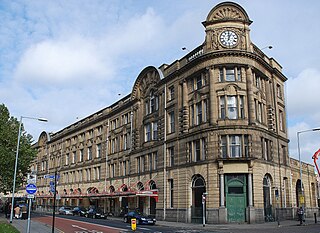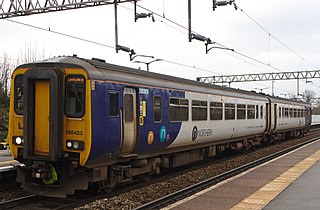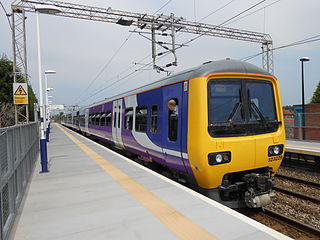
Manchester Piccadilly is the principal railway station in Manchester, England. Opened as Store Street in 1842, it was renamed Manchester London Road in 1847 and became Manchester Piccadilly in 1960. Located to the south-east of Manchester city centre, it hosts long-distance intercity and cross-country services to national destinations including London, Birmingham, Nottingham, Glasgow, Edinburgh, Cardiff, Bristol, Exeter, Plymouth, Reading, Southampton and Bournemouth; regional services to destinations in Northern England including Liverpool, Leeds, Sheffield, Newcastle and York; and local commuter services around Greater Manchester. It is one of 19 major stations managed by Network Rail. The station has 14 platforms: 12 terminal and two through platforms. Piccadilly is also a major interchange with the Metrolink light rail system with two tram platforms in its undercroft.

Manchester Metrolink is a tram/light rail system in Greater Manchester, England. The network has 99 stops along 64 miles (103 km) of standard-gauge route, making it the most extensive light rail system in the United Kingdom. Metrolink is owned by the public body Transport for Greater Manchester (TfGM) and operated and maintained under contract by a Keolis/Amey consortium. Over the 2022/23 financial year 36 million passenger journeys were made on the system.

Manchester Victoria station in Manchester, England, is a combined mainline railway station and Metrolink tram stop. Situated to the north of the city centre on Hunts Bank, close to Manchester Cathedral, it adjoins Manchester Arena which was constructed on part of the former station site in the 1990s. Opened in 1844 and part of the Manchester station group, Victoria is Manchester's third busiest railway station after Piccadilly and Oxford Road and the second busiest station managed by Northern after Oxford Road.

Class 316 and Class 457 were TOPS classifications assigned to a single electric multiple unit (EMU) at different stages of its use as a prototype for the Networker series.

The Manchester–Preston line runs from the city of Manchester to Preston, Lancashire, England. It is largely used by commuters entering Manchester from surrounding suburbs and cities, but is also one of the main railway lines in the North West and is utilised by TransPennine Express regional services and to Scotland. It was announced in December 2009 that the line would be electrified, following an announcement in July 2009 that the Chat Moss line between Manchester and Liverpool was to be electrified first. The electrification work for this line commenced in May 2015 and was due for completion in May 2018, but was delayed until December 2018.

There once were four direct railway routes between Liverpool and Manchester in the North West of England; only two remain, the two centre routes of the four. The most northerly and the most southerly of the four routes are no longer direct lines. Of the remaining two direct routes, the northern route of the two is fully electric, while the now southern route is a diesel-only line. The most northerly of the four has been split into two routes: the western section operated by Merseyrail electric trains and the eastern section by diesel trains, requiring passengers to change trains between the two cities. The fourth route, the most southerly of the four, has been largely abandoned east of Warrington; the remaining section caters mainly for freight trains.

The Styal line is a suburban commuter railway line which runs through south Manchester, England; it commences at Slade Lane Junction, 1.2 miles (1.9 km) south of Manchester Piccadilly, and ends 12 miles (19 km) south at Wilmslow.

Hazel Grove railway station is a junction on both the Stockport to Buxton and Stockport to Sheffield lines, serving the village of Hazel Grove, Greater Manchester, England.

The Glossop line is a railway line connecting the city of Manchester with the towns of Hadfield and Glossop in Derbyshire, England. Passenger services on the line are operated by Northern Trains.

An electric multiple unit (EMU) is an electric self-powered train, capable of operating in multiple with other EMUs and without the need for a locomotive; these are typically passenger trains with accommodation in every vehicle and a driving position at each end. The term can also be used to describe a train that is a permanent formation with a non-driving power car, such as the Advanced Passenger Train. As of December 2010, two-thirds of the passenger carriages in Great Britain are formed in EMUs.

St Peter's Square is a tram stop in St Peter's Square in Manchester city centre, England. It opened on 27 April 1992 and is in Zone 1 of Greater Manchester's Metrolink light rail system. The stop's platforms were extended in 2009. Later redevelopment in 2015–16 demolished the original two side platforms and replaced them with a twin-island platform layout which allows for limited cross-platform interchange.

The Manchester South Junction and Altrincham Railway (MSJ&AR) was a suburban railway which operated an 8+1⁄2-mile (14 km) route between Altrincham in Cheshire and Manchester London Road railway station in Manchester.

Picc-Vic was a proposed, and later cancelled, underground railway designed in the early 1970s with the purpose of connecting two major mainline railway termini in Manchester city centre, England. The name Picc-Vic was a contraction of the two station names, Manchester Piccadilly and Manchester Victoria. The proposal envisaged the construction of an underground rail tunnel across Manchester city centre. The scheme was abandoned in 1977 during its proposal stages due to excessive costs, and that the scheme still retained two large and expensive-to-maintain terminal stations in Manchester; other similar sized cities had reduced their terminals to one.

Railway electrification in Great Britain began in the late 19th century. A range of voltages has been used, employing both overhead lines and conductor rails. The two most common systems are 25 kV AC using overhead lines, and the 750 V DC third rail system used in Southeast England and on Merseyrail. As of March 2020, 3,758 miles (6,048 km) (38%) of the British rail network was electrified.

The transport infrastructure of Greater Manchester is built up of numerous transport modes and forms an integral part of the structure of Greater Manchester and North West England – the most populated region outside of South East England which had approximately 301 million annual passenger journeys using either buses, planes, trains or trams in 2014. Its position as a national city of commerce, education and cultural importance means the city has one of the largest and most thorough transport infrastructures which is heavily relied upon by its 2.8 million inhabitants in the Greater Manchester conurbation and further afield in the North West region. Public transport comes under the jurisdiction of Transport for Greater Manchester.

The history of Manchester Metrolink begins with its conception as Greater Manchester's light rail system in 1982 by the Greater Manchester Passenger Transport Executive, and spans its inauguration in 1992 and the successive phases of expansion.

Greater Manchester Passenger Transport Executive was the public body responsible for public transport in Greater Manchester between 1974 and 2011, when it became part of Transport for Greater Manchester.
This timeline of Manchester Metrolink lists significant events in the history of Greater Manchester's light rail network.

The Altrincham Line is a tram line of the Manchester Metrolink running from Manchester to Altrincham in Greater Manchester. Originally a railway line, it was, along with the Bury Line, converted into a tramway during 1991–92, as part of the first phase of the Metrolink system.
























